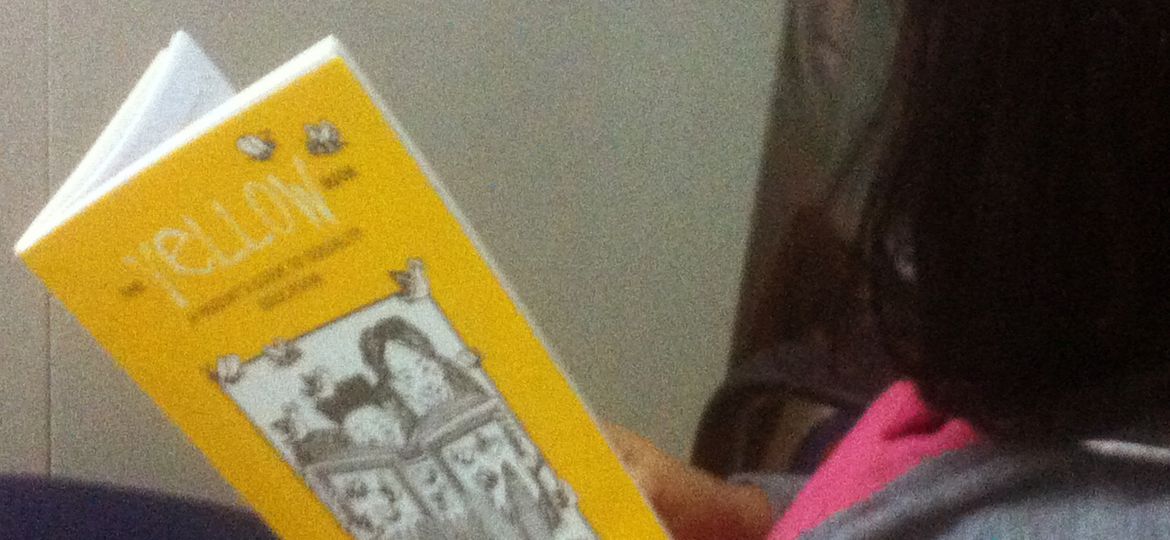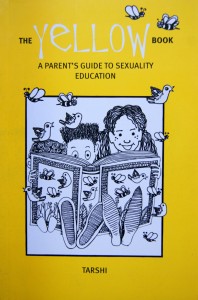
After the endless media coverage of the horrific gangrape in December 2012, words like rape, sex, vagina and so on have made far more appearance in common parlance than they ever had before. With a very curious 6 year old and an 8 year old on the verge of his tweens, I’ve worked hard to give them age appropriate information and keep things open and transparent. And also to accept that every child, regardless of current and social issues needs to be given constant and consistent sexuality education. An ongoing conversation that you build on. This is not easy to do in the lack of proper support from school, society and family. There are also plenty of international titles on the matter, but few in the Indian context. So it was extremely gratifying to receive TARSHI’s The Yellow Book – A Parent’s Guide to Sexuality Education.
The book is extremely clear in its mandate. In a country with a burgeoning population that still doesn’t believe in talking about sex openly, it wants to help parents and teachers deal with uncomfortable questions rather than brush them under the carpet. To ensure that young children are not dismissed, distracted or else confused by adults who are too awkward or even (Gasp!) ignorant of biology.
It opens with a chapter on how to use it. The book is divided into three sections – Ideas, Tips and Tools, and Factsheets and Resources.
Ideas is a section that really breaks down sex, sexuality and gender identities for adults who themselves often wonder where one begins and the other ends. I found this section the most vital, because it convinces adults about the importance of disseminating information to children. From facts and numbers from the WHO to the basics of every child’s right to information about his or her own body, the section convinces parents who are either fence sitters or convinced that sexuality education results in sexual activity that the opposite is true. That sexuality education is empowering and protects children from abuse.
What I loved was how each argument is presented – why are we ashamed to teach our children the correct names of their private parts when we take such pride in them learning the names of other body parts. Why indeed?!
The chapters are then broken into sections, helping you to prepare yourself, suggesting conversation starters and openings, ideas for a nervous or uncertain parent to draw from. Simple suggestions like practicing in front of a mirror or with a friend, taking off from a dog and its puppies.
The book also addresses the rather important topic of abuse right through. From ensuring privacy while a child bathes to keeping avenues for conversation open so that your child can always turn to you, the suggestions are simple and many. Chapters entitled preschool, primary and middle school help you to work through age appropriate information and offer you likely scenarios you might have to deal with, from diaper changes on siblings, to questions about breasts in public.
An important point they bring up is consistency in what parents teach their children. A discussion earlier on to decide where you both stand on religious and ethical values and with regard to sexual issues, so that the message you send out to your child isn’t confusing.
The last section of the book is packed with facts. If you’re unclear on basic biology it’s a quick recap to ensure that you don’t give kids the wrong facts. Menstruation, AIDS, abortions, CSA, rape, abusive relationships, it covers a gamut of information, partly statistical to educate a parent on how rampant such issues are so that they are not brushed under the carpet.
One of the biggest boons is that the book also takes into account children with disabilities and their sexual needs and issues. People with special needs are often discounted in matters of sexuality and all sexuality is stamped out. This is a good starting place for parents with such children, followed up by more resources they can turn to. That is one of the best things about the book. It does not claim to be the ultimate word on children and sexuality, pointing you instead to the internet and more resources.
Told in simple, lucid language and a chatty style, The Yellow Book is a great companion for both, the reticent parent as well as the enthusiastic one. A good way to supplement it would be through the Red and Blue books that TARSHI brought out prior to this. For now, this is a great place to start.
